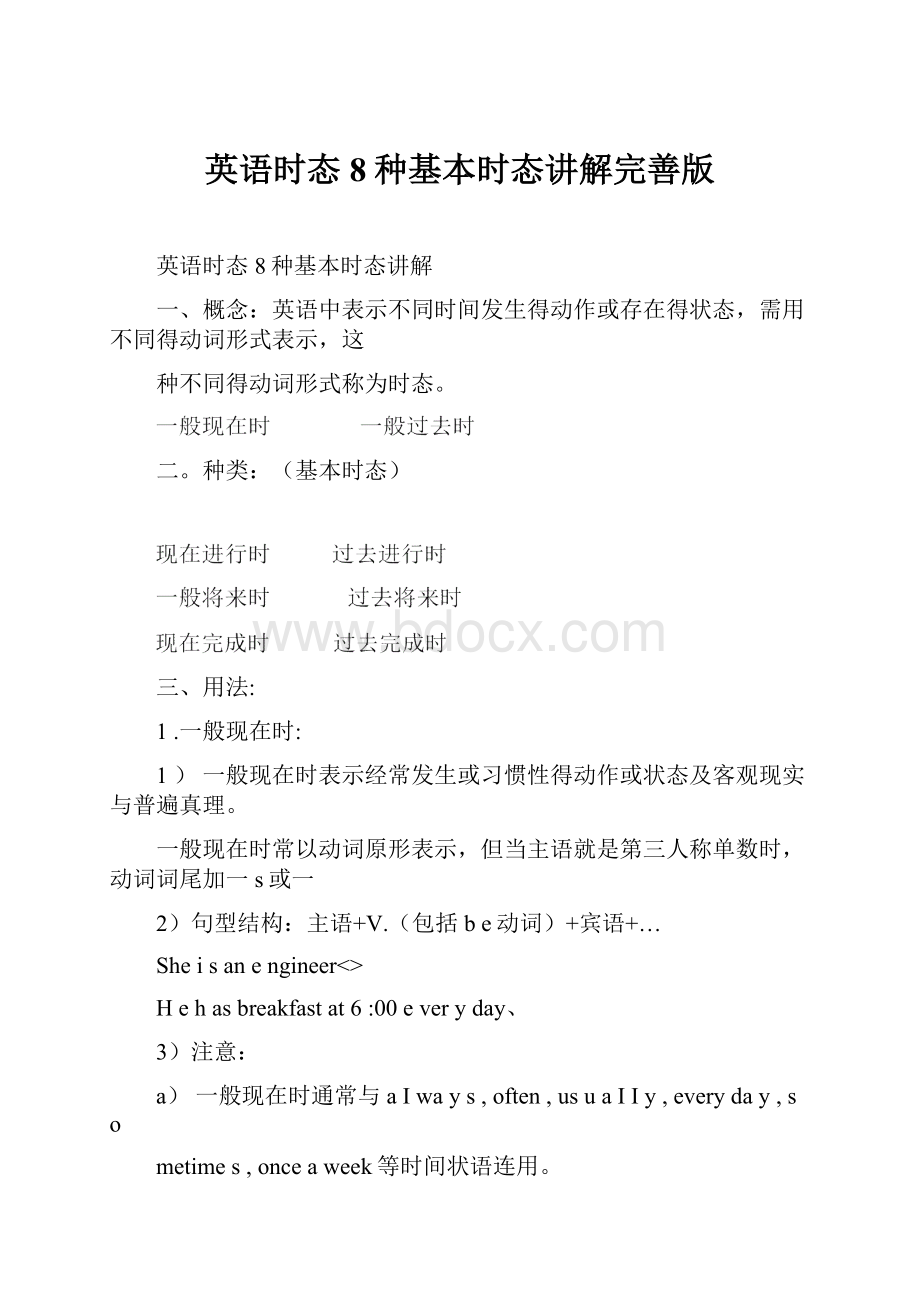英语时态8种基本时态讲解完善版.docx
《英语时态8种基本时态讲解完善版.docx》由会员分享,可在线阅读,更多相关《英语时态8种基本时态讲解完善版.docx(13页珍藏版)》请在冰豆网上搜索。

英语时态8种基本时态讲解完善版
英语时态8种基本时态讲解
一、概念:
英语中表示不同时间发生得动作或存在得状态,需用不同得动词形式表示,这
种不同得动词形式称为时态。
二。
种类:
(基本时态)
三、用法:
1.一般现在时:
1)一般现在时表示经常发生或习惯性得动作或状态及客观现实与普遍真理。
一般现在时常以动词原形表示,但当主语就是第三人称单数时,动词词尾加一s或一
2)句型结构:
主语+V.(包括be动词)+宾语+…
Sheisanengineer<>
Hehasbreakfastat6:
00everyday、
3)注意:
a)一般现在时通常与aIways,often,usuaIIy,everyday,so
metimes,onceaweek等时间状语连用。
IaIwayswatchTVat8:
00intheevening、
Theygohomeonceaweek。
WeusuaIIydoourhomeworkathome、
b)表客观现实或普遍真理。
ThesunaIwaysrisesintheeast.
TheIighttraveIsfasterthanthesound、
c)表永远性得动作或状态。
HeIivesinthecountry、
4)第三人称单数变化形式。
a)一般情况动词在词尾加一s。
comecomesspeakspeaksworkworkslive1ives
b)以o,s,x,ch,sh结尾得单词在词后加一es、
dodoesgogoesfinishfinishesbrushbrushes
fixfixespasspasseswatchwatches
c)以“辅音字母+y”结尾得单词变y为i加-es。
Studystudiescarry-carriescrycries
d)以“元音字母+y”结尾得单词直接加一s、
pIayplaysstaystays
例句:
我们每天晚上九点做作业、
我在早上七点半起床、
她每天七点去上班、
我们经常下午打篮球。
她喜欢音乐、
地球围绕太阳转。
火车六点出发。
5)否定句与疑问句。
a)Heisanengineero
Heisn'tanengineer>
Isheanengineer?
Yes,heiso/No,heisn?
to
b)Wegetupat7:
30inthemorning、
Wedon'tgetupat7:
30inthemorning0
Doyougetupat7:
30inthemorning?
Yes,wedo。
/No,wedon't、
c)HeIikesmusic、
Hedoesn11Iikemusic>
Doeshelikemusic?
Yes,hedoes./No,hedoesn*t.
2.一般过去时
1)一般过去时表示发生在过去得动作或存在得状态,通常与表示过去得时间状语yesterday,Iastnight,someyearsago,in1990,inthosedays>等连用、
Iwasastudent6yearsago。
IwenttoBeijingIastyear.
TheysawafiImIastnighto
2)句型结构:
主语+V、过去时+宾语+…
例句:
昨天她很忙。
去年她抽烟了。
两年前她去参军了。
她在1990年去世了。
3)否定句与疑问句。
a)Hewasbusyyesterday。
Hewasn*tbusy、
Washebusy?
Yes,hewas、/No,hewasn'to
b)Hesmokedlastyear、
Hedidn'tsmokeIastyear>
Didhesmokelastyear?
Yes,hedid°/No,hedidn?
t、
c)Hejoinedthearmyin1990.
Hedidn'tjoinedthearmyin1990。
Didhejointhearmyin1990?
Yes,hedido/No,hedidn't、
4)动词过去式变化规则。
a)一^殳情况下得词加一edo
workworkedcaIIcaIIedlaughIaughed
ExplainexpIainedfinishfinishedknockknock
ed
b)以不发音得字母e结尾得单词直接加-d、
Iive1ivedchangechangedsmokesmokeddie
-died
graduategraduateddrivedrove
c)以“辅音字母+y”结尾得单词,变y为i加一ed。
try1riedmarrymarried
d)以“元音字母+y”结尾得单词直接加一ed。
pIayplayedstaystayed
e)以“一个元音字母+一个辅音字母”结尾得单词应先双写这个辅音字母然后再加-ed.
stopstoppedpIanpIannedpatpatted
f)动词不规则变化:
dodidgowentcomecamerunranwrite
-wrote
beginbegandrinkdrankkeepkeptleaveleft
sIeepsIept
makemadeIieIaydigdugeatateknow—
——knew
cutcutsetsetletletreadreadhurthurt
例句:
我前天拿走了这本书。
去年我买了一辆自行车、
每天晚上我听音乐。
她通常待在家里、
两天前我完成了这项工作。
复习:
1)I(be)ateacher2yearsago。
2)He(be)astudentnow、
3)He_(do)hishomeworkathomeeveryday.
4)They(join)thePartyin1998。
5)We_(noteat)applesyesterday。
6)We(notplay)basketbalIeveryday.
7)He_(notgo)homeoneeaweek。
8)Iam16yearsoId、(划线部分提问)
9)Igotoworkat8:
OOeverymorning>(划线部分提问)
10)TheyjoinedthePartyin1990。
(划线部分提问)
11)IwenttoBeijinglastyear。
(划线部分提问)
3.一般将来时
1)表示将来发生得动作或.存在得状态,常与表将来得时间状语tomorrow,thedayaftertomorrow,nextSunday,soon,inafewdays等连用。
2)句型结构:
主语+wiIl/shaII+V>原形+…(第一人称用shalI)
IshallgotoShanghaitomorrow>
TheywiIIhaveameetingnextweek.
Shewillbe20yearsold、
-WiIIshebe20yearsoId?
Yes,shewiII>/No,shewon't。
3)主语+will/shall+V。
原形+…
be(am,is,are)goingto
TheywillhaveameetingnextSunday、
(wiII=aregoingto)
WhatwiIItheydonextSunday?
Whenwilltheyhaveameeting?
4)beaboutto+Vo原形
IamabouttoIeaveschooI、
不能与表示时间得副词连用。
Theyareabouttosetout>(J)
Theyareabouttosetoutsoon。
(X)
复习题:
1.He_(do)hishomeworkatschooleveryday
2oThey(finish)theirworkyesterday。
3oWe_(visit)theirfarmnextyear.
4o我半小时后要吃午饭。
5o她将骑自行车去学校°6o她们下周日将去买汽车、
4.过去将来时
1)过去将来时就是立足于过去某时,从过去得观点瞧将要发生得动作或状态。
主要用于宾语从句中。
2)基本结构:
主语+wouId/shouldwas/weregoingto+Vo原形+…
HesaidthathewouIdhaveameetingnextweek.
(Hesaysthathewillnaveameetingnextweek、)
TheysaidweshouIdIeaveschooItomorrowo
(TheysayweshaIIleaveschooltomorrow。
)
5、现在进行好
1)现在进行时表示现在或现在这段时间正在进行得动作、通常与now,atpresent等时间状语连用。
2)基本结构:
主语+be(am,is,are)+v—ing+…
YouareIisteningtomecarefullynow>
Sheiswritingaletterthisyear。
Look!
Theyaredancing。
VIearestudyingEngIishatpresent>
It*sraininghardnow、
3)动词现在分词得构成
①一般动词直接在词后加-ing
do-doingread-reading
work-workingthink-thinking
study-studyinggo-going
watch-watchingjump-jumping
2以不发音得字母e结尾得动词,应先去掉e然后加・ing
Iike-Iikingtake-taking
leave-Ieavinglive-living
receive-receivingdance-dancing
e-comingsmoke-smoking
write-writing
3以“一个元音字母+一个辅音字母”结尾得动词,应先双写这个辅音字母然后再加一ing
stop-stoppingbegin-beginning
dig-diggingswim-swimming
run-runningsit-sitting
(注意:
Iisten-Iisteningopen-openingeat-eating
rain-rainingsIeep-sleeping)
4)
6、过去进而
1)表示过去某一时刻或某阶段时间正在进行得动作,通常与at6:
00yesterda
y,atthis/thattimeyesterday,when引导得时间状语等连用。
2)基本结构主语+be(was/were)+v—ing+•••
1oItwasrainingat7:
00thedaybeforeyesterday>
2oTheywerebuiIdingareservoiratthistimeIast
winter>
3<>Wewerereadingwhentheteachercamein.
Weweren'treading•••
Wereyoureading…
Whatwereyoudoingwhentheteachercamein、
3)例句1、前天那个时候Tom正在瞧电影。
2.上周日四点我们正在游泳。
3。
师瞧见我们时我们正在玩扑克。
4OI(do)myhomeworkyesterdayo
5、He(do)hishomeworkat5:
00yesterday、
6oHe(do)hishomeworknow.
7.现在完成时
1)1.表示过去发生得动作对现在造成得影响
2、表示过去某时间已经开始一直持续到现在得动作或状态
recently,
ever,
通常与下列时间状语连用uptonow,inthepast,by…,for5years,since1994,sofar,aIready,yetjust…
2)基本结构主语+have/has+P。
P(动词过去分词)
1、I1vefinishedthiswork.
2、HehaseverbeentoAustraliao
3oIhavenotheardfromherrecently。
4oIhaveaIreadyreadthisbook、
Haveyouread…?
Yes,IhaveoNo,Ihaven't.
Whathaveyouread?
3)过去分词得构成(规则变化同过去式得构成)
不规则变化如下
dodiddonegowentgoneeatateeaten
ecamecomehavehadhad
writewrotewritten
bewas/werebeen
seesawseen
hearheardheard
swimswamswum
drinkdrankdrunk
givegavegiven
forgetforgotforgotten
taketooktaken
keepkeptkept
sleepsIeptslept
teachtaughttaught
buyboughtboughttelltoldtoId
makemademade
hurthurthurtreadreadread
letIetlet
4)注意
1o含有终止意义或暂短意义得动词不能与for,sinee引导得一般时间状语连用。
(buy,begin,die,e,go,join,Ieave等)
A)Ihaveboughtabook。
1haveboughtabookfor3day.(wrong)
Ihavehadabookfor3years。
B)Hehavejoinedthearmyfor3yearso(wrong)
Hehasbeeninthearmyfor3years、
Hejoinedthearmy3yearsago。
C)Hehasbeendeadfor3years。
Hedied2yearsago.
Itis2yearssincehedied。
Hehasdiedfor2years.(wrong)
D)HehasgonetoAustralia.
HehasbeentoAustralia、
2、现在完成时与一般过去时得区别(时间状语得区别)
I(hear)formherrecently/yesterday。
3、例句:
她已经闵读了这本书。
我们到目前为止已学习了两千个单词。
她们居住在中国三年了。
她瞧这部电影两次了、
Bob自从1997年在这所学校教学。
|8。
过去完成好
1)表示动作发生在过去某一时间之前已经完成得动作或状态,强调“过去得过去“,常与bythetime,bytheendof…,before,by等引导时间得状语连用。
也就就是用来表示发生在过去得两个事件动作中哪一个发生在前
2)基本结构主语+had+动词过去分词+…
WhenIgottothecinemayesterdaythefiImhadbegunaIready.
昨天当我到达电影院时电影已经开始了。
HehadIearnedEnglishbeforehecamehere>
她来这儿之前已经学会英语了、
Hehadaughtthisclassfor3yearsbythetimeIIefttheschooI。
当我离开这个学校为止她已教这个班级三年了。
BytheendoflasttermIhadIearned2000EngIishwords.
到这学期末我已学会了2000个英语单词。
注意:
hadbeen就是延续性动词,与段时间连用;
had就是非延续性动词,与点时间连用。
IhadbeenworkinginIondonforoneyearbeforeyoucamehere
Ihadworkinlondonbeforeyoucamehere.
时态部分总复习题
IoFillintheblanks.
1oV/eusuallyget(get)upat7:
00everymorningo(
2.Shewaswatching(watch)TVwhensheheardaIoudknockatthedoorthistimeyesterday>
3.MymotherwiIIcome(e)heretomorrow、
4.Look!
Someonearedancing(dance)there>5^V/eiHua,sbrotherjoined(join)thearmyin1995.
60Hewrites(write)aIetterthisafternoon.
7、Ricegrows(grow)inthesouthofChina、
8、Shesaidwouldgoing(go)toJapannextyearo
9oWehadstudied(study)2,000wordssincewecametothes
chooI.
10。
Bytheendoflasttermhehasteaching(teach)thatclassfor2years>
IIoTranslation
(1)我每天早上7点通常打篮球。
(2)昨天我去游泳了。
(3)昨天她说她们将于后天去参观长城。
(4)我们将在下学期学习俄语。
(5)她现在正在玩游戏。
(6)去年冬天这个时候她们正在盖房子。
(7)我居住在山东20年了。
(8)到上月末为止她工作十年了。